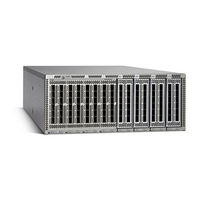Cisco Nexus 6000 Manuals
Manuals and User Guides for Cisco Nexus 6000. We have 4 Cisco Nexus 6000 manuals available for free PDF download: Configuration Manual, Installation Manual, Reference Manual
Cisco Nexus 6000 Configuration Manual (216 pages)
Table of Contents
-
Overview
21 -
-
-
-
Domain Ids32
-
-
-
Procedure
35 -
-
Example
35
-
-
Step 5
35 -
Step 1
39 -
Step 1
40-
Example
40
-
-
-
-
NPV Overview47
-
NPV Mode48
-
NP Uplinks49
-
-
-
-
-
NPV Features61
-
-
-
-
-
Interop Mode97
-
-
-
-
Zone Sets106
-
Enhanced Zoning118
-
-
-
-
-
Fabric Login139
-
-
Fdmi142
-
Displaying FDMI143
-
Rscn143
-
Multi-Pid Option144
-
-
-
-
-
Enabling DHCHAP157
-
DHCHAP Password161
-
-
-
Auto-Learning176
-
-
-
Switch WWN Lists193
-
Advertisement
Cisco Nexus 6000 Configuration Manual (232 pages)
NX-OS Layer 2 guide
Table of Contents
-
Preface
13 -
Overview
21-
Vlans21
-
Chapter21
-
-
STP Overview22
-
Rapid PVST23
-
Mst23
-
-
-
-
-
-
-
Port Roles69
-
Port States70
-
Port Cost74
-
-
-
-
-
MST Overview87
-
MST Regions88
-
MST Bpdus88
-
Hop Count92
-
-
Enabling MST95
-
-
-
Overview111
-
-
-
-
RMAC Learning129
-
-
-
C H a P T E
135 -
Configuring MVR
143-
Configuring MVR145
-
C H a P T E
151 -
C H a P T E
165 -
-
Oversubscription173
-
Management Model174
-
Forwarding Model175
-
Connection Model175
-
-
Chassis179
-
-
-
-
VM-FEX Overview203
-
-
-
-
Cisco Nexus 6000 Installation Manual (86 pages)
Nexus 6000 Series
Table of Contents
-
Preface
7 -
Overview
15-
-
Chassis16
-
Power Supply17
-
-
-
-
Fan Modules18
-
Transceivers18
-
-
-
-
Advertisement



